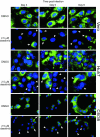c-Src protein kinase inhibitors block assembly and maturation of dengue virus
- PMID: 17360676
- PMCID: PMC1805510
- DOI: 10.1073/pnas.0611681104
c-Src protein kinase inhibitors block assembly and maturation of dengue virus
Abstract
Dengue virus is a mosquito-borne flavivirus that represents an important emerging infectious disease and is an international health concern. Currently, there is no vaccine or effective antiviral therapy to prevent or to treat dengue virus infection. The slow progress in developing antiviral agents might be alleviated by the availability of efficient high-throughput anti-dengue virus screening assays. In this study, we report an immunofluorescence image-based assay suitable for identification of small molecule inhibitors of dengue virus infection and replication. Using this assay, we have discovered that inhibitors of the c-Src protein kinase exhibit a potent inhibitory effect on dengue virus (serotypes 1-4) and murine flavivirus Modoc. Mechanism of action studies demonstrated that the c-Src protein kinase inhibitor dasatinib prevents the assembly of dengue virions within the virus-induced membranous replication complex. These results demonstrate that this cell-based screen may provide a powerful means to identify new potential targets for anti-dengue drug development while simultaneously providing pharmacological probes to investigate dengue virus-host cell interactions at the biochemical level. Given the simplicity and excellent reproducibility of the assay, it should be useful in high-throughput screens of both small molecule and RNAi libraries when implemented on a robotic image-based high-throughput screen (HTS) platform. Given the reasonable clinical safety of inhibitors such as dasatinib and AZD0530, inhibitors of c-Src protein kinase may have the potential to become a new class of anti-dengue viral therapeutic agents.
Conflict of interest statement
The authors declare no conflict of interest.
Figures





Similar articles
-
The small molecules AZD0530 and dasatinib inhibit dengue virus RNA replication via Fyn kinase.J Virol. 2013 Jul;87(13):7367-81. doi: 10.1128/JVI.00632-13. Epub 2013 Apr 24. J Virol. 2013. PMID: 23616652 Free PMC article.
-
The kinase inhibitor SFV785 dislocates dengue virus envelope protein from the replication complex and blocks virus assembly.PLoS One. 2011;6(8):e23246. doi: 10.1371/journal.pone.0023246. Epub 2011 Aug 17. PLoS One. 2011. PMID: 21858043 Free PMC article.
-
A small molecule inhibitor of dengue virus type 2 protease inhibits the replication of all four dengue virus serotypes in cell culture.Virol J. 2015 Feb 8;12:16. doi: 10.1186/s12985-015-0248-x. Virol J. 2015. PMID: 25886260 Free PMC article.
-
Ten years of dengue drug discovery: progress and prospects.Antiviral Res. 2013 Nov;100(2):500-19. doi: 10.1016/j.antiviral.2013.09.013. Epub 2013 Sep 27. Antiviral Res. 2013. PMID: 24076358 Review.
-
Novel dual Src/Abl inhibitors for hematologic and solid malignancies.Expert Opin Investig Drugs. 2010 Aug;19(8):931-45. doi: 10.1517/13543784.2010.499898. Expert Opin Investig Drugs. 2010. PMID: 20557276 Review.
Cited by
-
Flaviviruses are sensitive to inhibition of thymidine synthesis pathways.J Virol. 2013 Sep;87(17):9411-9. doi: 10.1128/JVI.00101-13. Epub 2013 Jul 3. J Virol. 2013. PMID: 23824813 Free PMC article.
-
Targeting Human Proteins for Antiviral Drug Discovery and Repurposing Efforts: A Focus on Protein Kinases.Viruses. 2023 Feb 19;15(2):568. doi: 10.3390/v15020568. Viruses. 2023. PMID: 36851782 Free PMC article. Review.
-
LINC08148 promotes the caveola-mediated endocytosis of Zika virus through upregulating transcription of Src.J Virol. 2024 Jun 13;98(6):e0170523. doi: 10.1128/jvi.01705-23. Epub 2024 May 14. J Virol. 2024. PMID: 38742902 Free PMC article.
-
The small molecules AZD0530 and dasatinib inhibit dengue virus RNA replication via Fyn kinase.J Virol. 2013 Jul;87(13):7367-81. doi: 10.1128/JVI.00632-13. Epub 2013 Apr 24. J Virol. 2013. PMID: 23616652 Free PMC article.
-
Structure-Activity Relationship Study of QL47: A Broad-Spectrum Antiviral Agent.ACS Med Chem Lett. 2017 Feb 3;8(3):344-349. doi: 10.1021/acsmedchemlett.7b00008. eCollection 2017 Mar 9. ACS Med Chem Lett. 2017. PMID: 28337328 Free PMC article.
References
Publication types
MeSH terms
Substances
Grants and funding
LinkOut - more resources
Full Text Sources
Other Literature Sources
Chemical Information
Miscellaneous

